Proposals to Convert Jeju Island's Internationally Important
Seongsan Po Wetland into a Marine Resort.
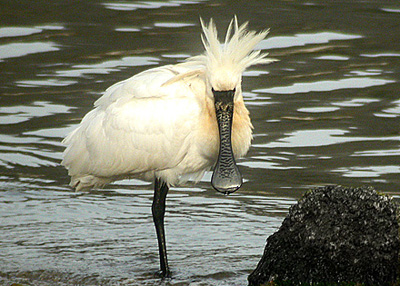
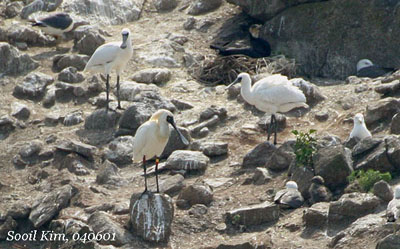
On an island with very limited tidal-flat or brackish wetland, the Black-faced Spoonbills are confined to two small coastal wetlands in the far southeast of the island (the Hadori fishponds, and the Seongsan Po wetlands), with birds moving between the two sites, though apparently increasingly dependent on the larger Seongsan Po area. The birds have been counted regularly at both sites for a number of years, with 15 Black-faced Spoonbill counted there in 1995/1996, and between 20 and 29 in all winters since 2000: i.e. over 1% of the total world population of this still Endangered species (Yu, 2005). These are not only Korea's only regularly wintering Black-faced Spoonbill; they are also among the most northern wintering of the species anywhere within the species' range.
Jeju Island, while remote from the Korean mainland, is clearly not remote from unrelenting development pressure. As part of a series of wide-ranging national-led initiatives to promote Jeju Island as a new centre of excellence (resort-based, free trade zone, with English mooted as an official second language), the Jeju administrative authority announced in mid-2006 that they are proposing the extensive conversion of the Seongsan Po wetlands into a marine resort. Funded by both Jeju and national government funds, a consultation process (extending until the end of 2006) has been opened, to discuss the merits and details of the proposed “Seongsan Po Marine Resort Area.” This Resort Area, very similar to a rival one apparently already being proposed for only a few kilometers west of there, could include A Sea Observatory; a Welcome Arcade; A Sunrise Plaza; a Sea Water Spa-land, an Exhibition Hall, an Entertainment complex, a Marine Theme Park, a Leisure and Sports Centre (with speed-boat racing), condominiums and hotels, all apparently supported with 387 Million US dollars equivalent of funding.
Birds Korea has now initiated correspondence on the issue with local specialists, and welcomes advice and support in order to help provide decision-makers and conservationists on Jeju Island with best advice – on how to conserve the Black-faced Spoonbills while strengthening the local economy of this outstandingly beautiful and internationally important area.
Reference
- Yu, Y.T. (2005) The International Black-faced Spoonbill Census: 21-23 January 2005. The Hong Kong Birdwatching Society. Hong Kong.
For further information of work to conserve Black-faced Spoonbills in Taiwan (a model with potentially direct relevance to conservation of the threatened wetlands in Jeju), please see the following pdfs kindly provided by SAVE International (http://www.earthisland.org/save):
Butler, B. 2002.
Ecotourism Takes Flight. Published by SAVE International.Hester, J. Undated/2003.
Land Use and Community Design to Ensure Jobs and Survival of Platelea minor. Unpublished SAVE International/University of California, Berkeley document.Hou, J. 1999.
Non-governmental Sector Involvement in the Conservation and Eco-tourism Development of Chiku Wetlands, Taiwan. Paper for presentation at 13th Sesssion of the Global Biodiversity Forum.Kuo, I-C. Undated.
A Sharing Homeland: Community-based wintering site management of Black-faced Spoonbill in Taiwan. SAVE International, for presentation at symposium in Jeju.
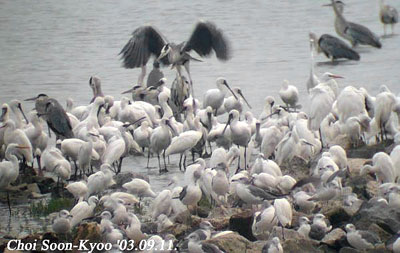
To whomsoever it may concern.
Based on information provided to Birds Korea, and on personal knowledge of the area, any major resort development of this wetland at Seongsan Po will very likely have a significant negative impact on the Black-faced Spoonbills Platelea minor that depend on the site, as well as on the ecosystem as a whole.
Birds Korea therefore respectfully offers local groups and decision-makers its support to help raise awareness of the issue, and to help develop some alternative vision.
Although the site (including Ojori Lake, and adjacent areas of beach, tidal-flat, sea-shallows and lava reef) has very obvious local and national value (being the only regular area to support wintering Black-faced Spoonbill in Korea), we believe that one main priority is to clarify that this is first and foremost an internationally important wetland. In accordance with the guidelines of the Ramsar Convention, the Seongsan Po wetlands regularly support an internationally important concentration (more than 1%) of a waterbird species, the Black-faced Spoonbill. It also might be considered internationally important in that it is an unusual and representative type of wetland – a tidal-flat/lagoon system in a lava-dominant area.
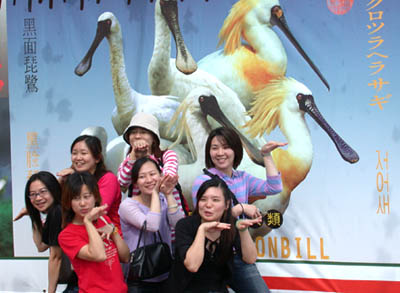
As the Seongsan Po wetlands are internationally important, their management and use needs to be considered fully in accordance with Ramsar guidelines – especially appropriate at this time as South Korea will host the next Ramsar Convention conference in 2008. Based on examples elsewhere (most especially in Taiwan and in Hong Kong), we believe that the area could be developed very usefully for eco-tourism and environmental education – much more in accordance both with Jeju Island's national image (as a place of beauty), and with its international aspirations. Such plans could include, for example, the better screening and protection of the area from traffic and disturbance; the construction of birdwatching hides, trails and education boards; and the construction of a discrete SE Jeju environmental education and activities centre, for use by tourists and school-children. Such a use would sustain the area's unique values (including its wildlife); increase revenue and local employment, especially in the winter months; and clarify Jeju Island's status as a leader in sustainable development.
It is important to state that bird-watching based ecotourism is one of the fastest growing industries in the developed world; that it generates huge income in many developed nations (1); and that sites suitable for such tourism, and developed appropriately for it, are significantly lacking in South Korea up to now.
Fully in the spirit of cooperation, Birds Korea would therefore like to ask respectfully if some of the following have yet been considered in the assessment process:
Has data on the use of Black-faced Spoonbills of the site been prepared, presented to, and understood by, decision-makers?
Have leading ornithologists involved in Black-faced Spoonbill research at Seongsan Po been contacted (2), and their opinions sought on this development?
Have the Ministry of Environment been contacted for their opinion, as the Black-faced Spoonbill is an endangered and protected species, and the Ministry is the focal point for the Ramsar Convention in Korea?
Have ecologists and administrators within the Ministry of Maritime Affairs been contacted? As reclamation of public waters is intended, should this development not fall under the Public Waters Reclamation Act, thus requiring ministerial and national approval?
Have the international Black-faced Spoonbill Network or Birdlife International, or the Ramsar Bureau been informed of the threats to this site? Are they being encouraged to develop an opinion and to assess the plans?
Have trained and independent ecologists, e.g. such as those belonging to Specialist Working Groups on e.g. Storks and Spoonbills, been informed of the plans and have they been invited to participate in assessing them?
Have data on environmental economics relating to this site (and Hadori) been prepared, and if so are they easily accessible? Is there clear evidence of the kind of tourism that visitors and local people would prefer?
Is an alternative, conservation-centred proposal being developed or considered by the conservation community or by local administrators? Although very demanding on limited resources, a well-designed alternative plan might enable local people and decision-makers to understand better the benefits of conservation.
Although Birds Korea has very limited capacity (with only 250 domestic and 400 international members [as of August 2006]), we offer our support to efforts of local groups and people, by communicating about this issue widely through our websites (nationally and internationally) and through direct mailing of relevant persons, especially those outside of Jeju and South Korea, if considered appropriate.
Although this wetland is a local treasure, it also nationally and internationally important. As such all of us should share responsibility to conserve the area and to use it wisely.
Respectfully,
Nial Moores
Director, Birds Korea
August, 2006
Open Letter from Yat-Tung YU, Co-ordinator, International Black-faced Spoonbill Census, on the Proposed Seongsan Po Marine Resort Development.
Dear Birds Korea,
Thank you very much for your email and the information about the development in Seongsanpo.
Seongsanpo is an important site for the globally endangered Black-faced Spoonbill because it supports 1% of the world known population of this species. Any development which will have a negative impact on the site will also threaten the survival of this endangered species. Further details could be referred to in the latest report of the 2006 International Black-faced Spoonbill census (available at: http://www.hkbws.org.hk/bfs/index.html ).
I worry very much that this development will bring adverse impact to the spoonbills and their site. Jeju Island is the only wintering site of the Black-faced Spoonbill in Korea. Also, I am sorry that this development plan seems to not have been consulted with both local and international experts and conservation organisations. As a coordinator of the International census of the Black-faced Spoonbill, I had not been informed about this development plan.
I strongly suggest the project proponents to stop any work on this project immediately and to start a detailed consultation regarding to the impact of the Black-faced Spoonbill from the development project.
Best regards,
Yat-tung YU
Coordinator
International Black-faced Spoonbill Census
Hong Kong Bird Watching Society
Hong Kong
(The Hong Kong Birdwatching Society is an affiliated partner of Birdlife International, the global bird conservation organisation, and a formal NGO partner to the Ramsar Convention. The survey itself is coordinated by Mr. Yu Yat-Tung, and is supported by the Birdlife International Asia Division. In addition, the 2005 survey involved approximately 160 individual contributors, 10 bird societies or conservation groups, as well as WWF in Hong Kong, and the Birdlife International Indochina Programme.)
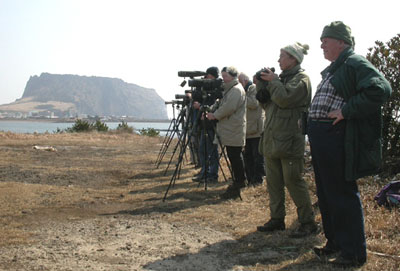
Additional Notes
Bird watching has become a major industry which generates US$25 billion per year and employs over 60,000 people, according to a front-page report in the New York Times (4/2/2001). The article noted that birdwatching is a non-consumptive use of renewable resources that depends upon the protection of wildlands and wilderness habitat, and thrives and grows on the protection of biodiversity.
“There has been a rapid growth in public interest in birds and other wildlife in many Asian countries, including in Korea, and birdwatching and similar activities could soon develop into a major leisure industry in the region.” (Dr. Mike Rands, Director of Birdlife International, in litt. 2001).
Choi C-Y & Lee, W-S. (2004). Accurate Measurements and Comparisons of the Wintering Behaviors of Black-faced Spoonbills (Platelea minor): A First Step of Developing Conservational Efforts for Endangered Migratory Birds. In Proceedings of the 2004 International Symposium on Migratory Birds, Gunsan, Korea. pp 203-210.
For an excellent personal account on the Black-faced Spoonbill please go to:
drmartinwilliams.com: Black-faced Spoonbills
And also to this article on the wintering Black-faced Spoonbills at Chiku, Taiwan:
The Thin White Line



